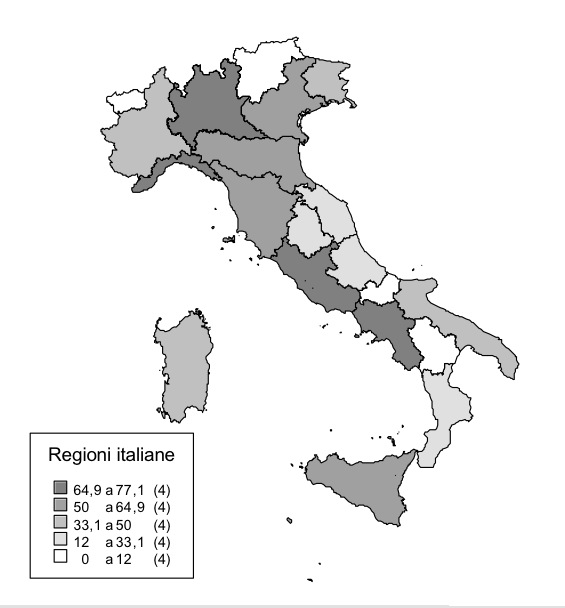Copyright 2000, P. Cinzano, Thiene, Italy
All rights reserved
The situation of light pollution in Italy
As indicators of the situation of light pollution in Italy we present some data on the stellar visibility, which give a good picture of how much artificial lighting alters the natural luminosity of the night environment.

Fraction of population of Italian regions which lives where the Milky Way is not visible per cent (from ISTIL Report 2001)
Light pollution of the night sky in Italy appears a more serious problem than commonly believed. The population percentages speak for themselves, indicating that large numbers of people in Italy have had their vision of the night sky severely degraded.
More than half of the Italian population lost the possibility to see his "home in the Universe", the Milky Way, even in the more clean nights due to light pollution. On more than three quarters of the Italian population "night" never really comes because the zenith sky brightness is larger than the typical zenith brightness at nautical twilight due to the excessive amount of artificial light.
Seven Italians on ten effectively live in perennial moonlight because the night sky in standard clean atmospheric conditions in the place where they live is brighter than has been measured in the nights close to full moon in the best astronomical sites. They rarely realize it because they still experience the sky to be brighter under a full moon than under new moon conditions.
About 100 per cent of the Italian population live in areas where the night sky is above the threshold considered polluted (i.e. the artificial sky brightness is greater than 10 per cent of the natural night sky brightness above 45 degrees of elevation (Smith 1979)).
These are some results of the ISTIL Report 2001 about Stato del cielo notturno e Inquinamento luminoso in Italia (The situation of the night sky and light pollution in Italy) published by the Light Pollution Science and Technology Institute (ISTIL). The Report was made by Pierantonio Cinzano (Università di Padova), Fabio Falchi (ISTIL) e Christopher Elvidge (National Geophysical Data Center, Boulder) and it is based on measurements made with the satellites of the Defence Meteorological Satellite Program. For more details see the original document. Statistical data about other world countries are available in The First World Atlas of Artificial Night Sky Brightness.
In Lombardy, Campania and Lazio approximately three quarters of the population have lost the possibility to see the Milky Way from the place where it lives, also in the more clean nights. In Liguria, Emilia-Romagna and Tuscany
two thirds of the population are in the same conditions. In Sicily, Veneto, Piemonte, Puglia and Friuli-Venezia-Giulia approximately half of the population cannot see the Milky Way. The percentage decreases to approximately a third in Sardinia and Marche and to a quarter in Abruzzi. In Umbria, Calabria and Molise only an inhabitant on ten lives in a place from which the Milky Way is totally invisible. The luckiest Regions are Trentino Alto-Adige, Basilicata and Valle d’Aosta where the Milky Way is still visible for almost everybody at least in the more clean nights. Of course these projections do not take into account local situations, e.g. who has the misfortune of living very near to a shopping centre illuminated for the entire night, and they refer to an observer with average eye capability and quite clean nights.
Still worse percentages are obtained if instead to consider how many people do not see of the Milky Way at all, we consider how many see it sufficiently well or easily. As an example in the Province of Padua two thirds of the population does not see the Milky Way anymore but only less than 4% of the inhabitants sees it acceptably in normal clear nights. More than 80% of the population of Molise and Basilicata can see a reasonable starred sky from the place where it lives (stars of fifth magnitudo), but the percentage decreases to two thirds in Trentino Alto Adige, Valle d’Aosta and Calabria, approximately half in Sardinia, Abruzzi and Umbria, one third in Marche, one quarter in Piemonte, Friuli-Venezia-Giulia and Sicily, one fifth in Tuscany and Puglia, less than one seventh in Veneto and Lazio, only one tenth in Emilia-Romagna, Campania, Liguria and still less in Lombardy. These percentages do not depend only from the situation of the sky but also from the distribution of the population in the territory.
The region with the larger surface with very good sky (visible stars of magnitudo 5,5) is Sardinia. The region with the larger fraction of surface having a very good sky is Basilicata with 81% of the territory while, surprisingly, the region with the smaller fraction is Veneto with less than one fifth of territory, probably only the mountains close to the borderline with Austria. Today to admire in its entirety one of the greatest spectacle of the nature it is necessary nearly always to move for hundred of kilometres.